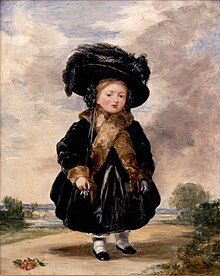Kensington System
This article needs additional citations for verification. (August 2018) |

The Kensington System was a strict and elaborate set of rules designed by Victoria, Duchess of Kent, along with her attendant, Sir John Conroy, concerning the upbringing of the Duchess's daughter, the future Queen Victoria. It is named after Kensington Palace in London, where they resided prior to Queen Victoria's accession to the throne.
Application
[edit]The System was aimed at rendering the young Princess Victoria weak and dependent and thus unlikely to adhere to her other relatives in the House of Hanover against her mother and Conroy. The young Victoria was never allowed to be apart from her mother, her tutor or her governesses (Baroness Lehzen and the Duchess of Northumberland). She was kept isolated from other children, and her mother and Conroy strictly monitored and recorded her every action and entirely controlled whom she was allowed to meet.[1]
It contained an element of surveillance: she wasn't allowed to sleep alone, play with other girls or even walk downstairs without having someone holding her hand. Each day she had to write in her 'Behaviour Book' how well or badly she'd behaved.[2]
Victoria had only two playmates during her adolescence: her half-sister, Princess Feodora of Leiningen, and Conroy's daughter, Victoire. Only occasional trips were made outside the palace grounds; two visits to Claremont to see her uncle Leopold I of Belgium greatly influenced Victoria's opinion on the System.[3] When it became clear that Victoria would inherit the throne, her keepers tried to induce Victoria to appoint Conroy her personal secretary and treasurer via a long series of threats and browbeating, to no avail.[citation needed]
Victoria's education began at the age of five. Her first teacher, Reverend George Davys, Dean of Chester, instructed her on scripture. The Duchess of Kent would personally drill her daughter after each lesson. At eight years old, Victoria began learning decorum, reading, and writing from Baroness Lehzen. She studied Greek, Latin, Italian, French, and German. The Duchess of Kent instituted a strict daily schedule for Victoria's education. Morning lessons began at 9:30 sharp with a break at 11:30. Lessons would resume for the afternoon at 3:00 and would last until 5:00.[4]
The system was endorsed by Queen Victoria's half-brother, Carl, 3rd Prince of Leiningen, who supported their mother's ambitions for a regency. In 1841, after Victoria had become queen and had made known her displeasure with the system, Carl attempted to justify it in his book A Complete History of the Policy Followed at Kensington, Under Sir John Conroy's Guidance.[5]
Aftermath
[edit]The System was an utter failure and backfired spectacularly. Victoria grew to hate her mother, Conroy, and her mother's lady-in-waiting (Lady Flora Hastings) over the system. Her first two requests, upon her accession four weeks after her 18th birthday (she received the delegation informing her of the king's death by herself), were that she should be allowed an hour by herself, which the System had never permitted, and that her bed should be removed from her mother's room, which presaged the cessation of her mother's influence, and, through her mother, that of Conroy.[6] Among Victoria's first acts upon her accession to the throne at the age of 18 was to ban Conroy from her apartments permanently.
After a brief engagement, Victoria married Prince Albert in 1840 and thus was no longer conventionally required to live with her mother. At the conclusion of her wedding ceremony, she shook hands only with the Duchess and soon evicted her mother from the palace. She rarely visited her mother and remained cold and distant from her until the birth of her first child.[citation needed]
References
[edit]- ^ Lacey, Robert (2006). Great Tales from English History, Volume 3. London: Little, Brown, and Company. pp. 133–136. ISBN 0-316-11459-6.
- ^ "Queen Victoria's unhappy childhood: life under the 'Kensington System'". HistoryExtra. Retrieved 30 May 2024.
- ^ Williams, Kate. Becoming Queen Victoria: The Tragic Death of Princess Charlotte and the Unexpected Rise of Britain's Greatest Monarch. New York: Ballantine, 2010. Print.
- ^ Rappaport, Helen (2003). Queen Victoria: A Biographical Companion. ABC-CLIO. ISBN 1-85109-355-9.
- ^ Rappaport, Helen (2003). Queen Victoria: A Biographical Companion. ABC-CLIO. pp. 218–220. ISBN 1-85109-355-9.
- ^ Professor Kate Williams (12 April 2015). "Queen Victoria: The woman who redefined Britain's monarchy". BBC i-Wonder. Retrieved 4 December 2015.
External links
[edit]- "Queen Victoria: the original people's princess" (14 September 2008) The Daily Telegraph
